Equity and Liabilities Items and Movements 15
VerifiedAdded on 2022/10/10
|15
|2876
|151
AI Summary
The article provides a detailed analysis of equity and liability items listed in the annual report of Commonwealth Bank of Australia and Westfarmers Limited. It explains the movements of these items across the years of comparison. The article also discusses the concepts of small and large proprietary company and reporting entity and explains the implication of a firm falling in either of the three classifications.
Contribute Materials
Your contribution can guide someone’s learning journey. Share your
documents today.
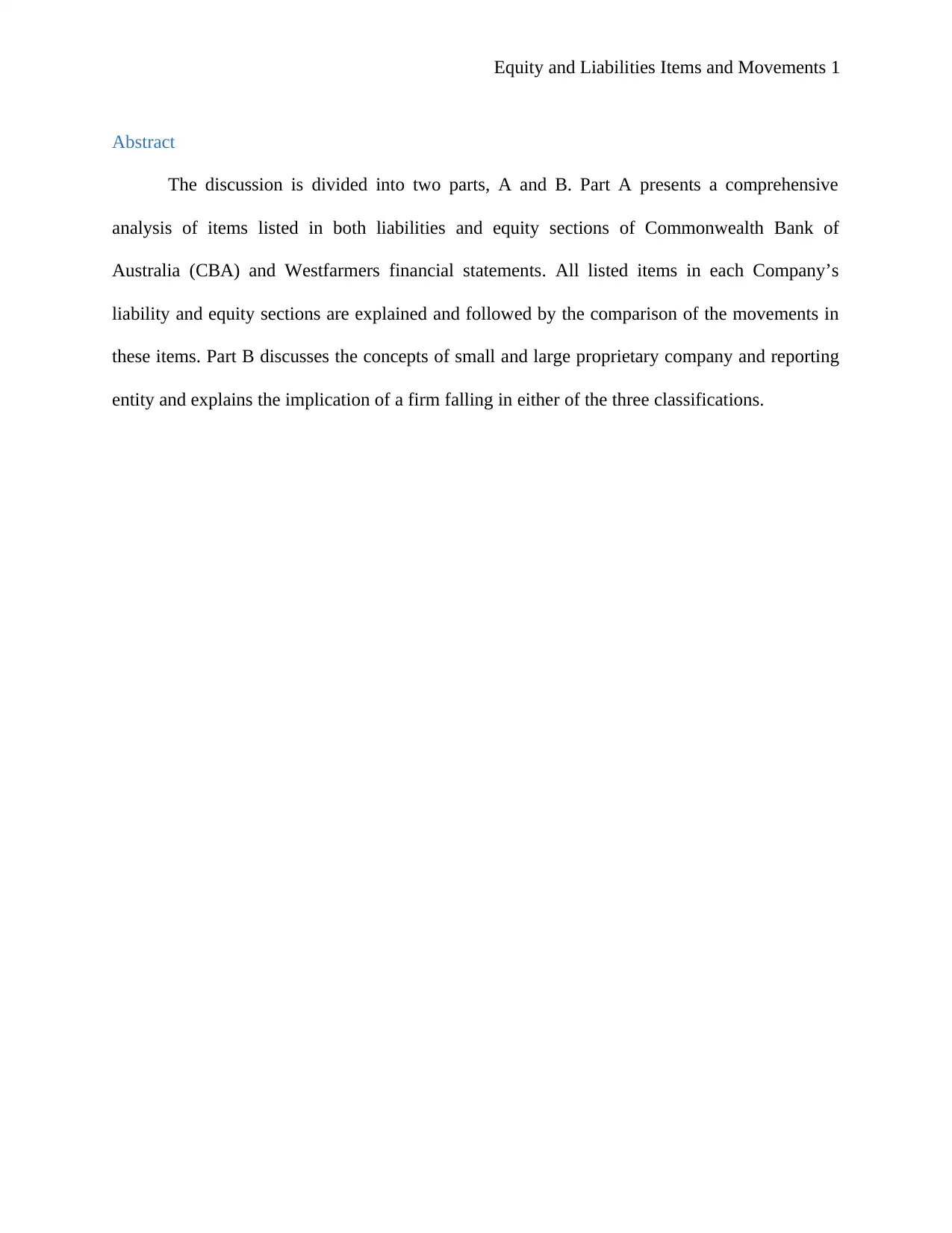
Equity and Liabilities Items and Movements 1
Abstract
The discussion is divided into two parts, A and B. Part A presents a comprehensive
analysis of items listed in both liabilities and equity sections of Commonwealth Bank of
Australia (CBA) and Westfarmers financial statements. All listed items in each Company’s
liability and equity sections are explained and followed by the comparison of the movements in
these items. Part B discusses the concepts of small and large proprietary company and reporting
entity and explains the implication of a firm falling in either of the three classifications.
Abstract
The discussion is divided into two parts, A and B. Part A presents a comprehensive
analysis of items listed in both liabilities and equity sections of Commonwealth Bank of
Australia (CBA) and Westfarmers financial statements. All listed items in each Company’s
liability and equity sections are explained and followed by the comparison of the movements in
these items. Part B discusses the concepts of small and large proprietary company and reporting
entity and explains the implication of a firm falling in either of the three classifications.
Secure Best Marks with AI Grader
Need help grading? Try our AI Grader for instant feedback on your assignments.
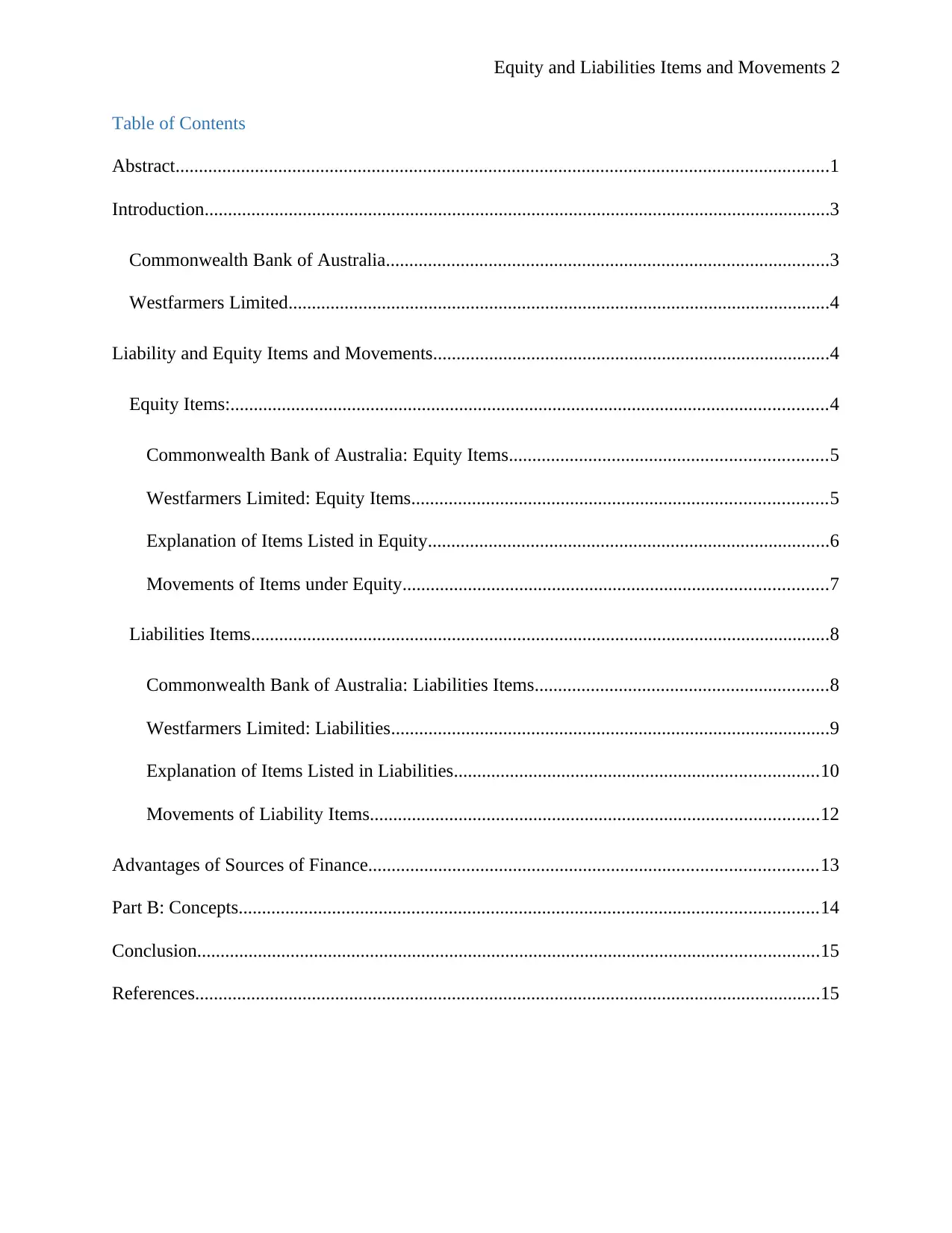
Equity and Liabilities Items and Movements 2
Table of Contents
Abstract............................................................................................................................................1
Introduction......................................................................................................................................3
Commonwealth Bank of Australia...............................................................................................3
Westfarmers Limited....................................................................................................................4
Liability and Equity Items and Movements.....................................................................................4
Equity Items:................................................................................................................................4
Commonwealth Bank of Australia: Equity Items....................................................................5
Westfarmers Limited: Equity Items.........................................................................................5
Explanation of Items Listed in Equity......................................................................................6
Movements of Items under Equity...........................................................................................7
Liabilities Items............................................................................................................................8
Commonwealth Bank of Australia: Liabilities Items...............................................................8
Westfarmers Limited: Liabilities..............................................................................................9
Explanation of Items Listed in Liabilities..............................................................................10
Movements of Liability Items................................................................................................12
Advantages of Sources of Finance................................................................................................13
Part B: Concepts............................................................................................................................14
Conclusion.....................................................................................................................................15
References......................................................................................................................................15
Table of Contents
Abstract............................................................................................................................................1
Introduction......................................................................................................................................3
Commonwealth Bank of Australia...............................................................................................3
Westfarmers Limited....................................................................................................................4
Liability and Equity Items and Movements.....................................................................................4
Equity Items:................................................................................................................................4
Commonwealth Bank of Australia: Equity Items....................................................................5
Westfarmers Limited: Equity Items.........................................................................................5
Explanation of Items Listed in Equity......................................................................................6
Movements of Items under Equity...........................................................................................7
Liabilities Items............................................................................................................................8
Commonwealth Bank of Australia: Liabilities Items...............................................................8
Westfarmers Limited: Liabilities..............................................................................................9
Explanation of Items Listed in Liabilities..............................................................................10
Movements of Liability Items................................................................................................12
Advantages of Sources of Finance................................................................................................13
Part B: Concepts............................................................................................................................14
Conclusion.....................................................................................................................................15
References......................................................................................................................................15
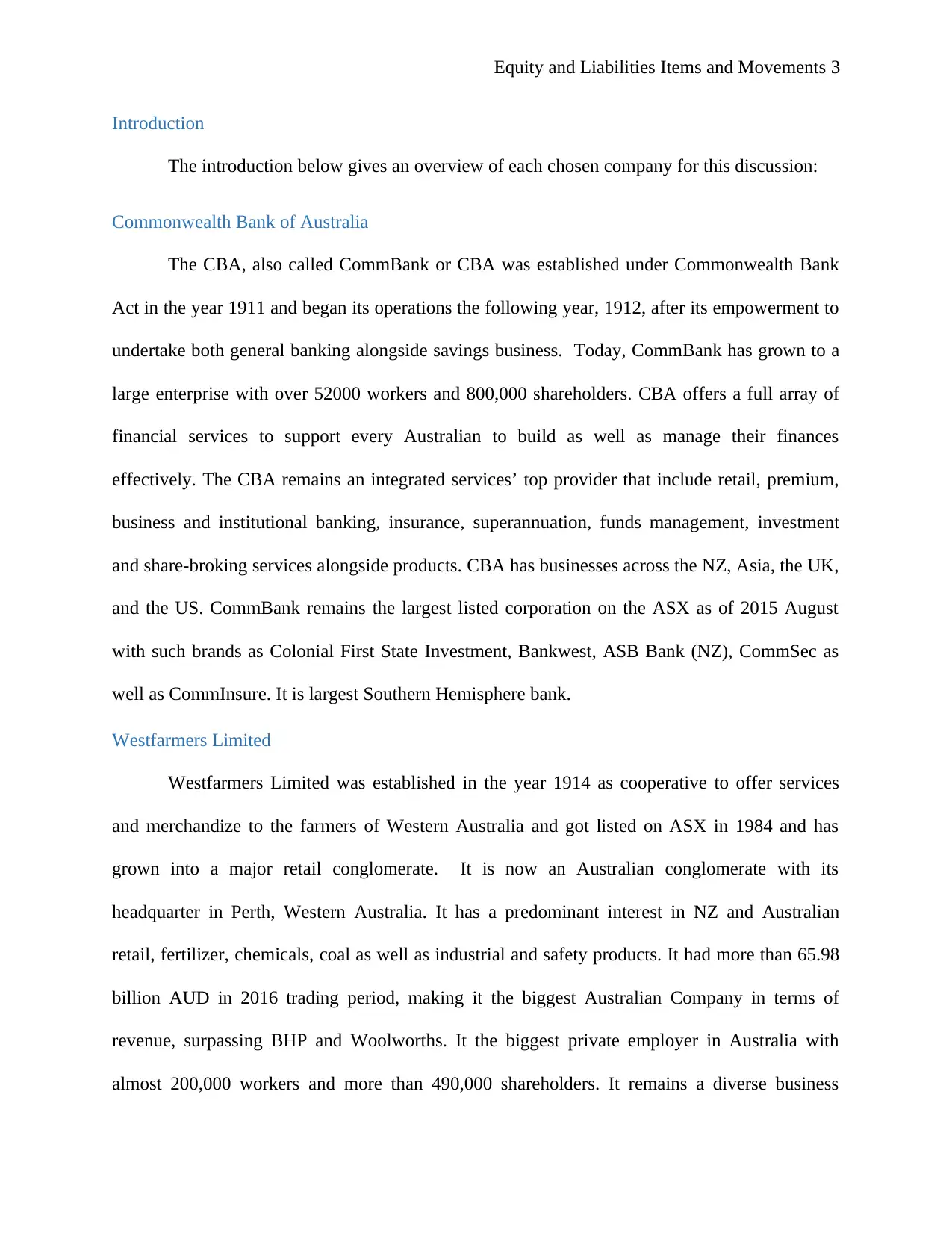
Equity and Liabilities Items and Movements 3
Introduction
The introduction below gives an overview of each chosen company for this discussion:
Commonwealth Bank of Australia
The CBA, also called CommBank or CBA was established under Commonwealth Bank
Act in the year 1911 and began its operations the following year, 1912, after its empowerment to
undertake both general banking alongside savings business. Today, CommBank has grown to a
large enterprise with over 52000 workers and 800,000 shareholders. CBA offers a full array of
financial services to support every Australian to build as well as manage their finances
effectively. The CBA remains an integrated services’ top provider that include retail, premium,
business and institutional banking, insurance, superannuation, funds management, investment
and share-broking services alongside products. CBA has businesses across the NZ, Asia, the UK,
and the US. CommBank remains the largest listed corporation on the ASX as of 2015 August
with such brands as Colonial First State Investment, Bankwest, ASB Bank (NZ), CommSec as
well as CommInsure. It is largest Southern Hemisphere bank.
Westfarmers Limited
Westfarmers Limited was established in the year 1914 as cooperative to offer services
and merchandize to the farmers of Western Australia and got listed on ASX in 1984 and has
grown into a major retail conglomerate. It is now an Australian conglomerate with its
headquarter in Perth, Western Australia. It has a predominant interest in NZ and Australian
retail, fertilizer, chemicals, coal as well as industrial and safety products. It had more than 65.98
billion AUD in 2016 trading period, making it the biggest Australian Company in terms of
revenue, surpassing BHP and Woolworths. It the biggest private employer in Australia with
almost 200,000 workers and more than 490,000 shareholders. It remains a diverse business
Introduction
The introduction below gives an overview of each chosen company for this discussion:
Commonwealth Bank of Australia
The CBA, also called CommBank or CBA was established under Commonwealth Bank
Act in the year 1911 and began its operations the following year, 1912, after its empowerment to
undertake both general banking alongside savings business. Today, CommBank has grown to a
large enterprise with over 52000 workers and 800,000 shareholders. CBA offers a full array of
financial services to support every Australian to build as well as manage their finances
effectively. The CBA remains an integrated services’ top provider that include retail, premium,
business and institutional banking, insurance, superannuation, funds management, investment
and share-broking services alongside products. CBA has businesses across the NZ, Asia, the UK,
and the US. CommBank remains the largest listed corporation on the ASX as of 2015 August
with such brands as Colonial First State Investment, Bankwest, ASB Bank (NZ), CommSec as
well as CommInsure. It is largest Southern Hemisphere bank.
Westfarmers Limited
Westfarmers Limited was established in the year 1914 as cooperative to offer services
and merchandize to the farmers of Western Australia and got listed on ASX in 1984 and has
grown into a major retail conglomerate. It is now an Australian conglomerate with its
headquarter in Perth, Western Australia. It has a predominant interest in NZ and Australian
retail, fertilizer, chemicals, coal as well as industrial and safety products. It had more than 65.98
billion AUD in 2016 trading period, making it the biggest Australian Company in terms of
revenue, surpassing BHP and Woolworths. It the biggest private employer in Australia with
almost 200,000 workers and more than 490,000 shareholders. It remains a diverse business
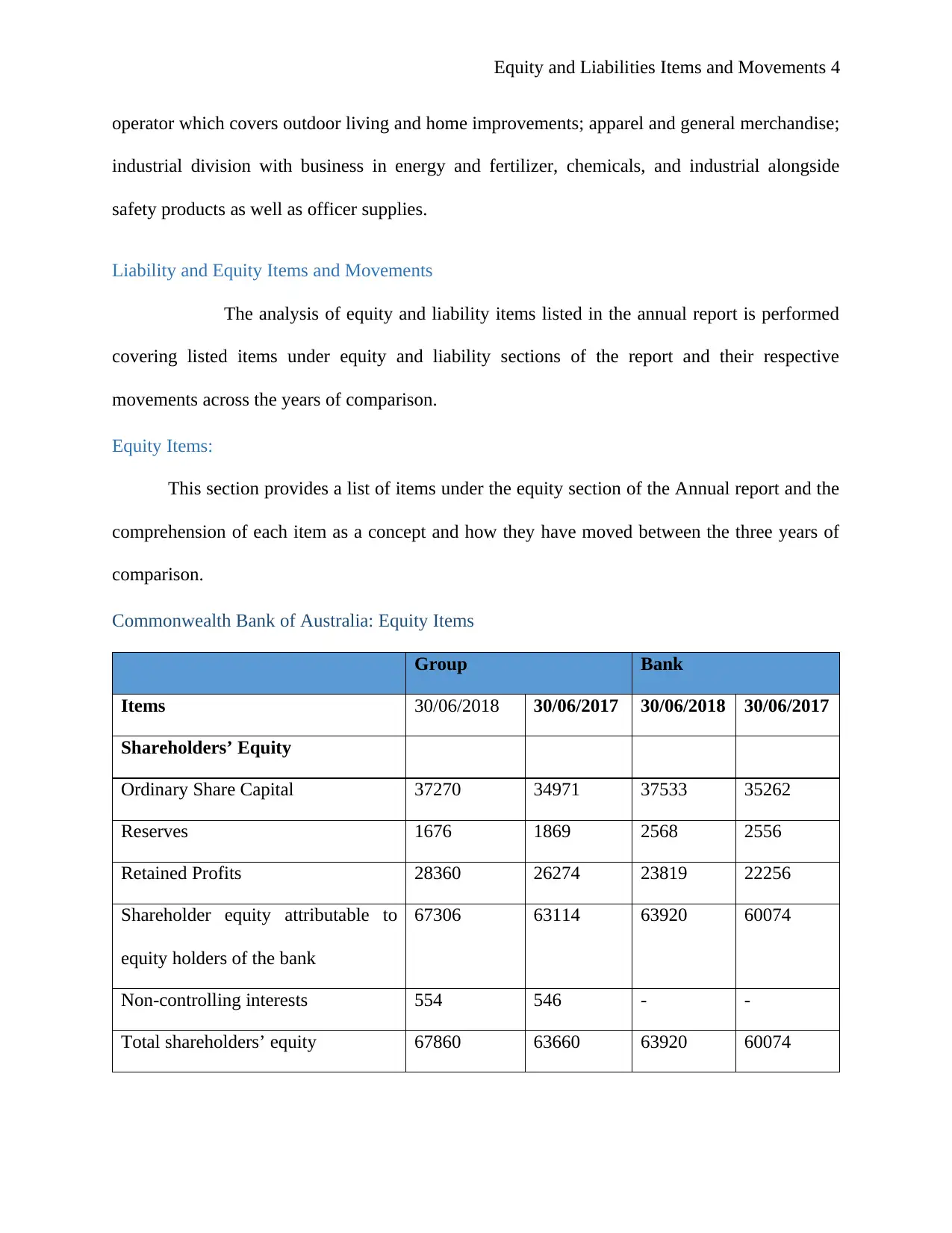
Equity and Liabilities Items and Movements 4
operator which covers outdoor living and home improvements; apparel and general merchandise;
industrial division with business in energy and fertilizer, chemicals, and industrial alongside
safety products as well as officer supplies.
Liability and Equity Items and Movements
The analysis of equity and liability items listed in the annual report is performed
covering listed items under equity and liability sections of the report and their respective
movements across the years of comparison.
Equity Items:
This section provides a list of items under the equity section of the Annual report and the
comprehension of each item as a concept and how they have moved between the three years of
comparison.
Commonwealth Bank of Australia: Equity Items
Group Bank
Items 30/06/2018 30/06/2017 30/06/2018 30/06/2017
Shareholders’ Equity
Ordinary Share Capital 37270 34971 37533 35262
Reserves 1676 1869 2568 2556
Retained Profits 28360 26274 23819 22256
Shareholder equity attributable to
equity holders of the bank
67306 63114 63920 60074
Non-controlling interests 554 546 - -
Total shareholders’ equity 67860 63660 63920 60074
operator which covers outdoor living and home improvements; apparel and general merchandise;
industrial division with business in energy and fertilizer, chemicals, and industrial alongside
safety products as well as officer supplies.
Liability and Equity Items and Movements
The analysis of equity and liability items listed in the annual report is performed
covering listed items under equity and liability sections of the report and their respective
movements across the years of comparison.
Equity Items:
This section provides a list of items under the equity section of the Annual report and the
comprehension of each item as a concept and how they have moved between the three years of
comparison.
Commonwealth Bank of Australia: Equity Items
Group Bank
Items 30/06/2018 30/06/2017 30/06/2018 30/06/2017
Shareholders’ Equity
Ordinary Share Capital 37270 34971 37533 35262
Reserves 1676 1869 2568 2556
Retained Profits 28360 26274 23819 22256
Shareholder equity attributable to
equity holders of the bank
67306 63114 63920 60074
Non-controlling interests 554 546 - -
Total shareholders’ equity 67860 63660 63920 60074
Secure Best Marks with AI Grader
Need help grading? Try our AI Grader for instant feedback on your assignments.
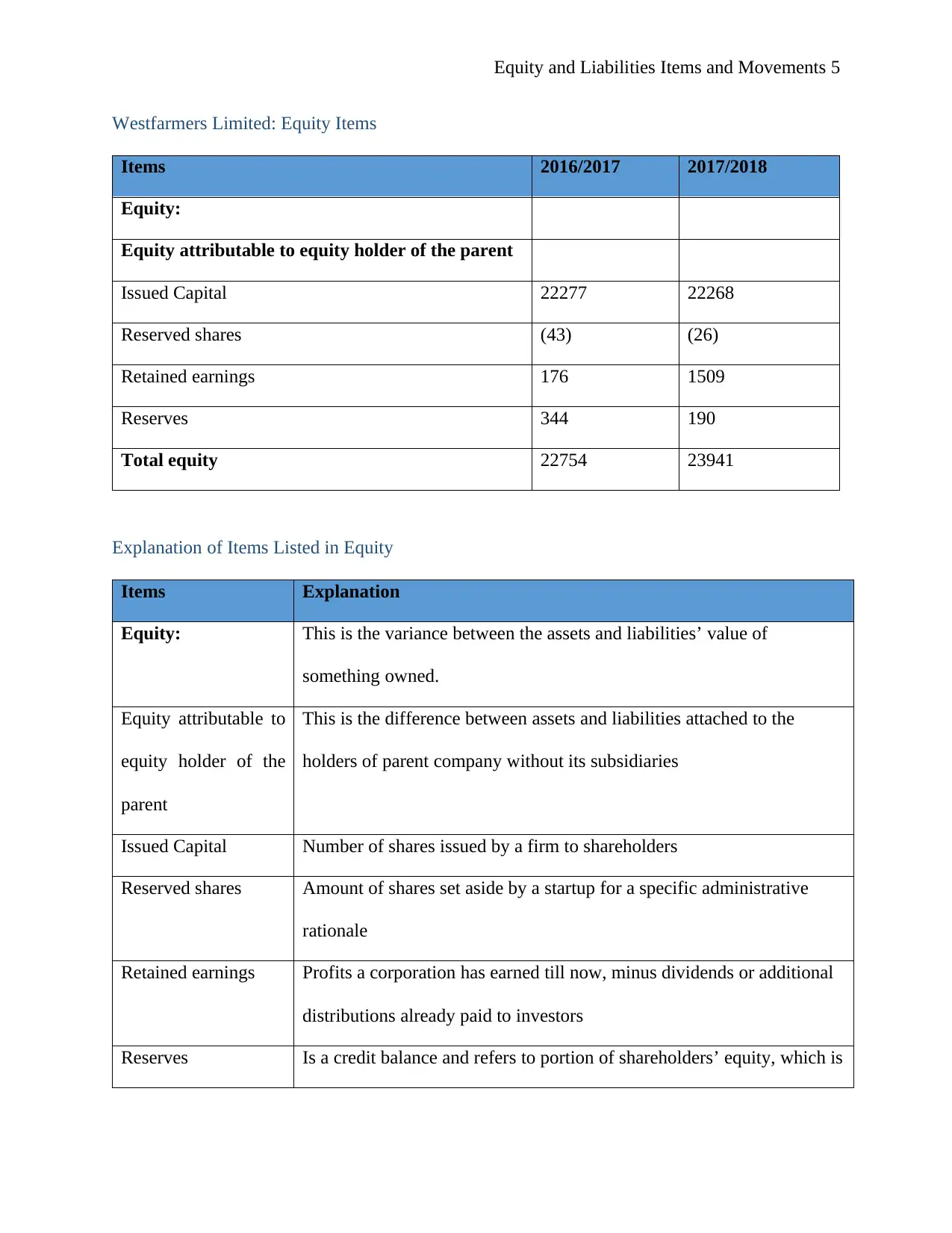
Equity and Liabilities Items and Movements 5
Westfarmers Limited: Equity Items
Items 2016/2017 2017/2018
Equity:
Equity attributable to equity holder of the parent
Issued Capital 22277 22268
Reserved shares (43) (26)
Retained earnings 176 1509
Reserves 344 190
Total equity 22754 23941
Explanation of Items Listed in Equity
Items Explanation
Equity: This is the variance between the assets and liabilities’ value of
something owned.
Equity attributable to
equity holder of the
parent
This is the difference between assets and liabilities attached to the
holders of parent company without its subsidiaries
Issued Capital Number of shares issued by a firm to shareholders
Reserved shares Amount of shares set aside by a startup for a specific administrative
rationale
Retained earnings Profits a corporation has earned till now, minus dividends or additional
distributions already paid to investors
Reserves Is a credit balance and refers to portion of shareholders’ equity, which is
Westfarmers Limited: Equity Items
Items 2016/2017 2017/2018
Equity:
Equity attributable to equity holder of the parent
Issued Capital 22277 22268
Reserved shares (43) (26)
Retained earnings 176 1509
Reserves 344 190
Total equity 22754 23941
Explanation of Items Listed in Equity
Items Explanation
Equity: This is the variance between the assets and liabilities’ value of
something owned.
Equity attributable to
equity holder of the
parent
This is the difference between assets and liabilities attached to the
holders of parent company without its subsidiaries
Issued Capital Number of shares issued by a firm to shareholders
Reserved shares Amount of shares set aside by a startup for a specific administrative
rationale
Retained earnings Profits a corporation has earned till now, minus dividends or additional
distributions already paid to investors
Reserves Is a credit balance and refers to portion of shareholders’ equity, which is
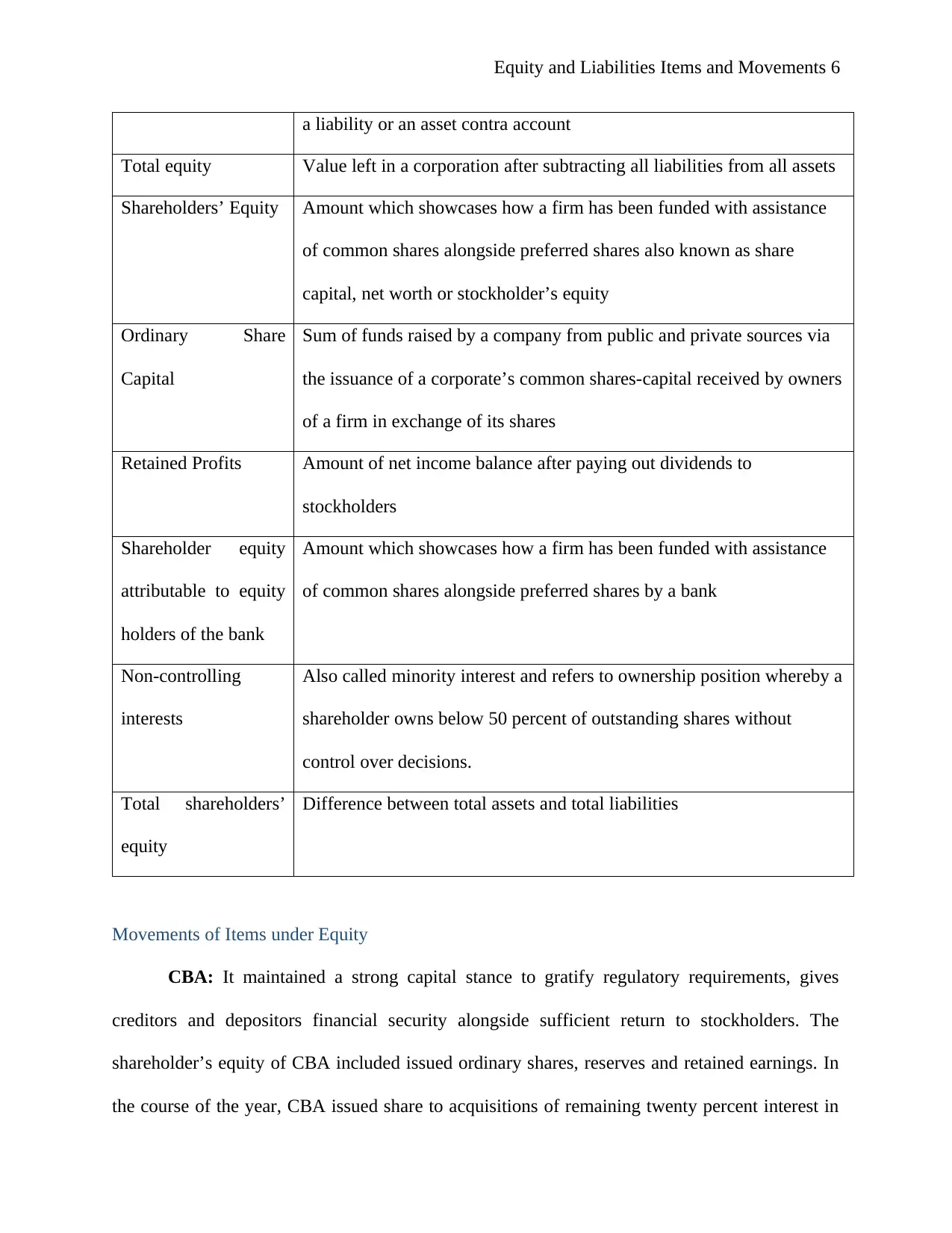
Equity and Liabilities Items and Movements 6
a liability or an asset contra account
Total equity Value left in a corporation after subtracting all liabilities from all assets
Shareholders’ Equity Amount which showcases how a firm has been funded with assistance
of common shares alongside preferred shares also known as share
capital, net worth or stockholder’s equity
Ordinary Share
Capital
Sum of funds raised by a company from public and private sources via
the issuance of a corporate’s common shares-capital received by owners
of a firm in exchange of its shares
Retained Profits Amount of net income balance after paying out dividends to
stockholders
Shareholder equity
attributable to equity
holders of the bank
Amount which showcases how a firm has been funded with assistance
of common shares alongside preferred shares by a bank
Non-controlling
interests
Also called minority interest and refers to ownership position whereby a
shareholder owns below 50 percent of outstanding shares without
control over decisions.
Total shareholders’
equity
Difference between total assets and total liabilities
Movements of Items under Equity
CBA: It maintained a strong capital stance to gratify regulatory requirements, gives
creditors and depositors financial security alongside sufficient return to stockholders. The
shareholder’s equity of CBA included issued ordinary shares, reserves and retained earnings. In
the course of the year, CBA issued share to acquisitions of remaining twenty percent interest in
a liability or an asset contra account
Total equity Value left in a corporation after subtracting all liabilities from all assets
Shareholders’ Equity Amount which showcases how a firm has been funded with assistance
of common shares alongside preferred shares also known as share
capital, net worth or stockholder’s equity
Ordinary Share
Capital
Sum of funds raised by a company from public and private sources via
the issuance of a corporate’s common shares-capital received by owners
of a firm in exchange of its shares
Retained Profits Amount of net income balance after paying out dividends to
stockholders
Shareholder equity
attributable to equity
holders of the bank
Amount which showcases how a firm has been funded with assistance
of common shares alongside preferred shares by a bank
Non-controlling
interests
Also called minority interest and refers to ownership position whereby a
shareholder owns below 50 percent of outstanding shares without
control over decisions.
Total shareholders’
equity
Difference between total assets and total liabilities
Movements of Items under Equity
CBA: It maintained a strong capital stance to gratify regulatory requirements, gives
creditors and depositors financial security alongside sufficient return to stockholders. The
shareholder’s equity of CBA included issued ordinary shares, reserves and retained earnings. In
the course of the year, CBA issued share to acquisitions of remaining twenty percent interest in
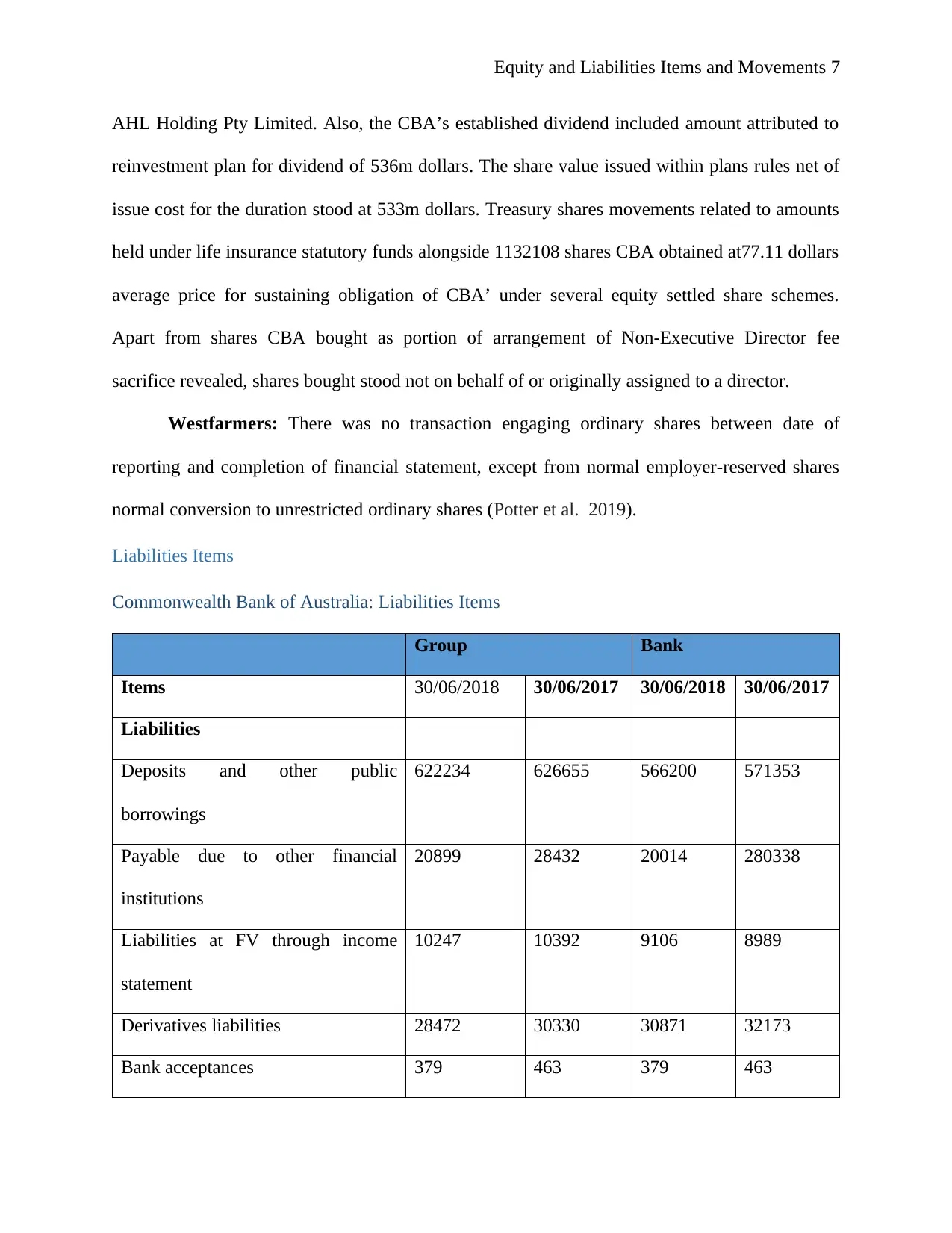
Equity and Liabilities Items and Movements 7
AHL Holding Pty Limited. Also, the CBA’s established dividend included amount attributed to
reinvestment plan for dividend of 536m dollars. The share value issued within plans rules net of
issue cost for the duration stood at 533m dollars. Treasury shares movements related to amounts
held under life insurance statutory funds alongside 1132108 shares CBA obtained at77.11 dollars
average price for sustaining obligation of CBA’ under several equity settled share schemes.
Apart from shares CBA bought as portion of arrangement of Non-Executive Director fee
sacrifice revealed, shares bought stood not on behalf of or originally assigned to a director.
Westfarmers: There was no transaction engaging ordinary shares between date of
reporting and completion of financial statement, except from normal employer-reserved shares
normal conversion to unrestricted ordinary shares (Potter et al. 2019).
Liabilities Items
Commonwealth Bank of Australia: Liabilities Items
Group Bank
Items 30/06/2018 30/06/2017 30/06/2018 30/06/2017
Liabilities
Deposits and other public
borrowings
622234 626655 566200 571353
Payable due to other financial
institutions
20899 28432 20014 280338
Liabilities at FV through income
statement
10247 10392 9106 8989
Derivatives liabilities 28472 30330 30871 32173
Bank acceptances 379 463 379 463
AHL Holding Pty Limited. Also, the CBA’s established dividend included amount attributed to
reinvestment plan for dividend of 536m dollars. The share value issued within plans rules net of
issue cost for the duration stood at 533m dollars. Treasury shares movements related to amounts
held under life insurance statutory funds alongside 1132108 shares CBA obtained at77.11 dollars
average price for sustaining obligation of CBA’ under several equity settled share schemes.
Apart from shares CBA bought as portion of arrangement of Non-Executive Director fee
sacrifice revealed, shares bought stood not on behalf of or originally assigned to a director.
Westfarmers: There was no transaction engaging ordinary shares between date of
reporting and completion of financial statement, except from normal employer-reserved shares
normal conversion to unrestricted ordinary shares (Potter et al. 2019).
Liabilities Items
Commonwealth Bank of Australia: Liabilities Items
Group Bank
Items 30/06/2018 30/06/2017 30/06/2018 30/06/2017
Liabilities
Deposits and other public
borrowings
622234 626655 566200 571353
Payable due to other financial
institutions
20899 28432 20014 280338
Liabilities at FV through income
statement
10247 10392 9106 8989
Derivatives liabilities 28472 30330 30871 32173
Bank acceptances 379 463 379 463
Paraphrase This Document
Need a fresh take? Get an instant paraphrase of this document with our AI Paraphraser
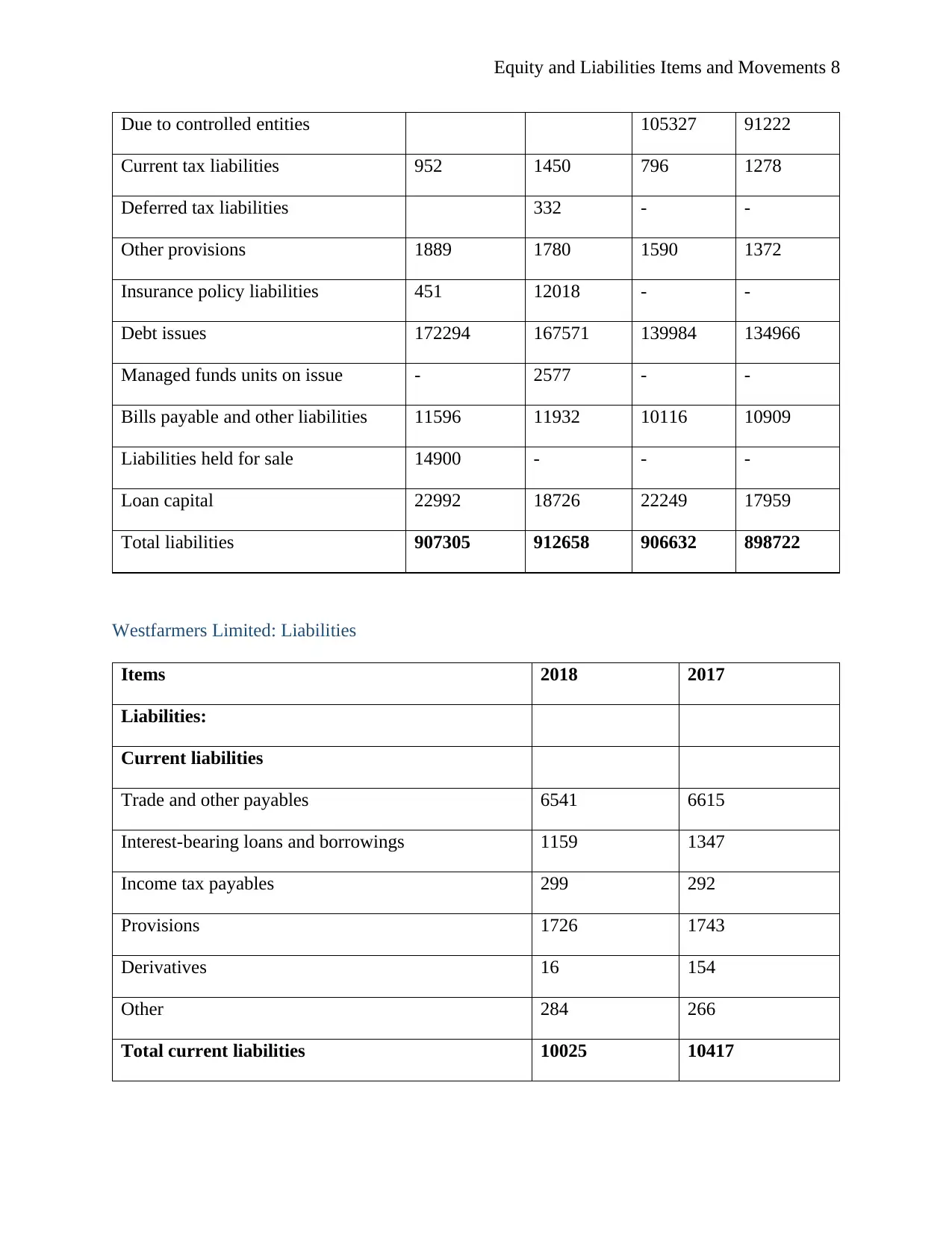
Equity and Liabilities Items and Movements 8
Due to controlled entities 105327 91222
Current tax liabilities 952 1450 796 1278
Deferred tax liabilities 332 - -
Other provisions 1889 1780 1590 1372
Insurance policy liabilities 451 12018 - -
Debt issues 172294 167571 139984 134966
Managed funds units on issue - 2577 - -
Bills payable and other liabilities 11596 11932 10116 10909
Liabilities held for sale 14900 - - -
Loan capital 22992 18726 22249 17959
Total liabilities 907305 912658 906632 898722
Westfarmers Limited: Liabilities
Items 2018 2017
Liabilities:
Current liabilities
Trade and other payables 6541 6615
Interest-bearing loans and borrowings 1159 1347
Income tax payables 299 292
Provisions 1726 1743
Derivatives 16 154
Other 284 266
Total current liabilities 10025 10417
Due to controlled entities 105327 91222
Current tax liabilities 952 1450 796 1278
Deferred tax liabilities 332 - -
Other provisions 1889 1780 1590 1372
Insurance policy liabilities 451 12018 - -
Debt issues 172294 167571 139984 134966
Managed funds units on issue - 2577 - -
Bills payable and other liabilities 11596 11932 10116 10909
Liabilities held for sale 14900 - - -
Loan capital 22992 18726 22249 17959
Total liabilities 907305 912658 906632 898722
Westfarmers Limited: Liabilities
Items 2018 2017
Liabilities:
Current liabilities
Trade and other payables 6541 6615
Interest-bearing loans and borrowings 1159 1347
Income tax payables 299 292
Provisions 1726 1743
Derivatives 16 154
Other 284 266
Total current liabilities 10025 10417
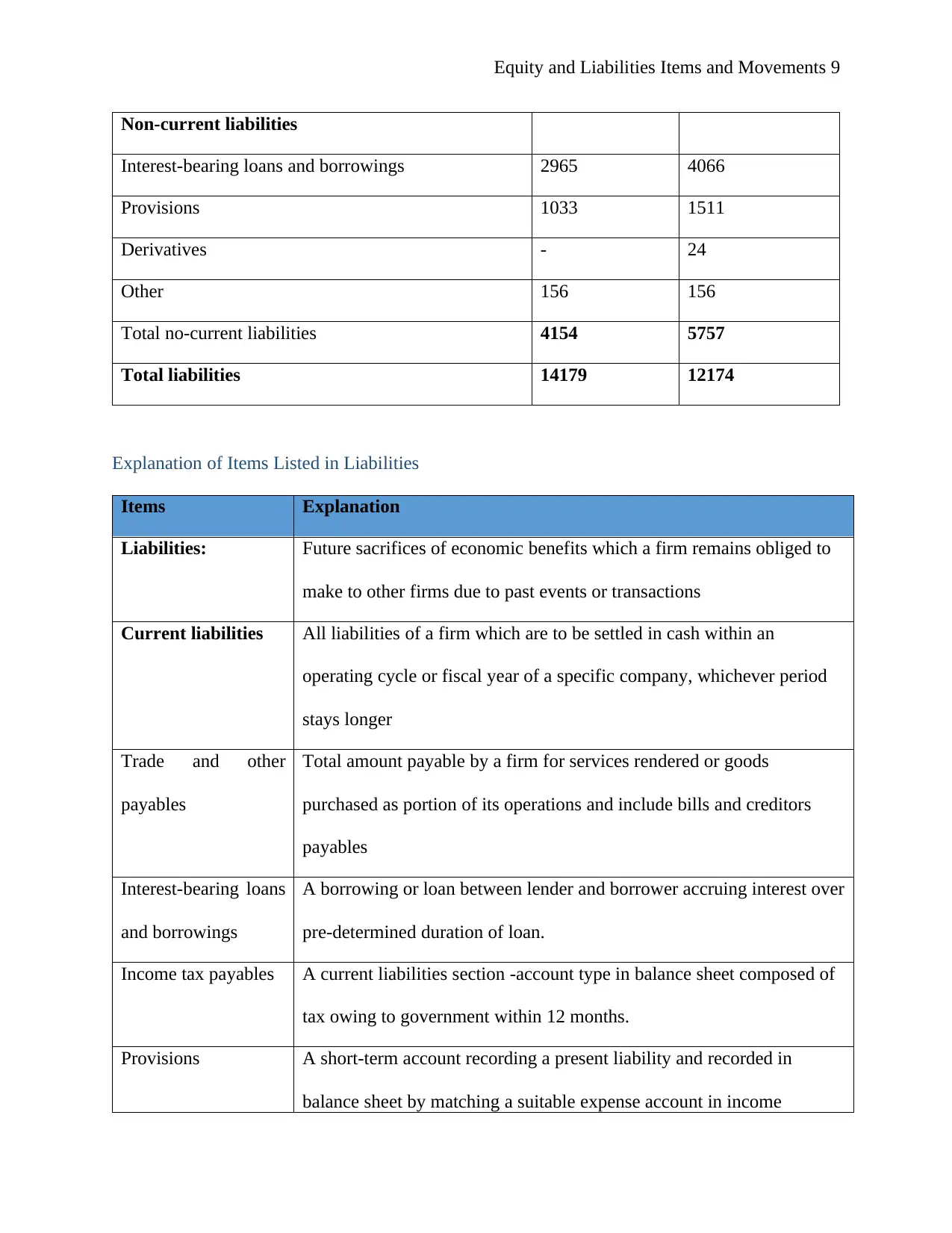
Equity and Liabilities Items and Movements 9
Non-current liabilities
Interest-bearing loans and borrowings 2965 4066
Provisions 1033 1511
Derivatives - 24
Other 156 156
Total no-current liabilities 4154 5757
Total liabilities 14179 12174
Explanation of Items Listed in Liabilities
Items Explanation
Liabilities: Future sacrifices of economic benefits which a firm remains obliged to
make to other firms due to past events or transactions
Current liabilities All liabilities of a firm which are to be settled in cash within an
operating cycle or fiscal year of a specific company, whichever period
stays longer
Trade and other
payables
Total amount payable by a firm for services rendered or goods
purchased as portion of its operations and include bills and creditors
payables
Interest-bearing loans
and borrowings
A borrowing or loan between lender and borrower accruing interest over
pre-determined duration of loan.
Income tax payables A current liabilities section -account type in balance sheet composed of
tax owing to government within 12 months.
Provisions A short-term account recording a present liability and recorded in
balance sheet by matching a suitable expense account in income
Non-current liabilities
Interest-bearing loans and borrowings 2965 4066
Provisions 1033 1511
Derivatives - 24
Other 156 156
Total no-current liabilities 4154 5757
Total liabilities 14179 12174
Explanation of Items Listed in Liabilities
Items Explanation
Liabilities: Future sacrifices of economic benefits which a firm remains obliged to
make to other firms due to past events or transactions
Current liabilities All liabilities of a firm which are to be settled in cash within an
operating cycle or fiscal year of a specific company, whichever period
stays longer
Trade and other
payables
Total amount payable by a firm for services rendered or goods
purchased as portion of its operations and include bills and creditors
payables
Interest-bearing loans
and borrowings
A borrowing or loan between lender and borrower accruing interest over
pre-determined duration of loan.
Income tax payables A current liabilities section -account type in balance sheet composed of
tax owing to government within 12 months.
Provisions A short-term account recording a present liability and recorded in
balance sheet by matching a suitable expense account in income
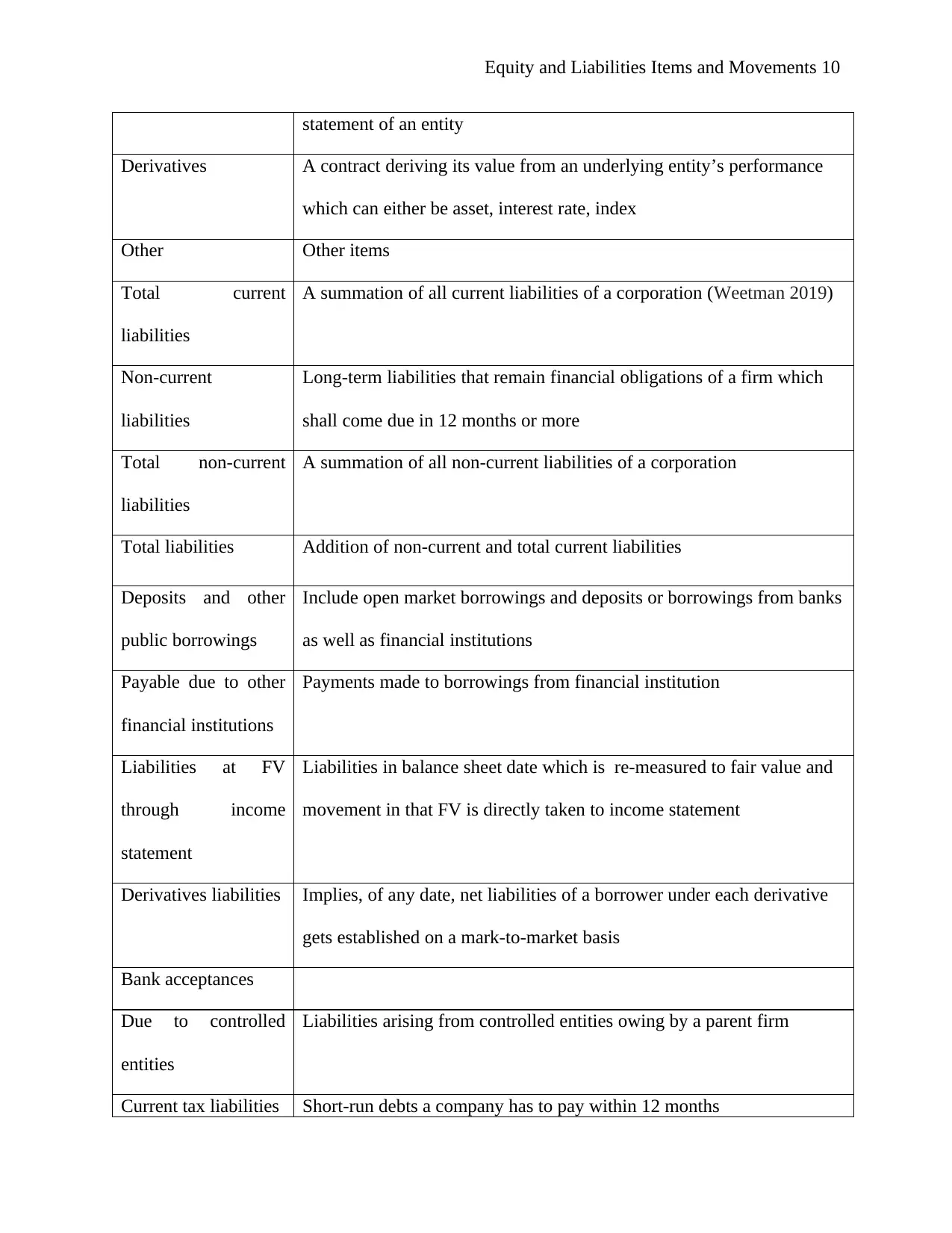
Equity and Liabilities Items and Movements 10
statement of an entity
Derivatives A contract deriving its value from an underlying entity’s performance
which can either be asset, interest rate, index
Other Other items
Total current
liabilities
A summation of all current liabilities of a corporation (Weetman 2019)
Non-current
liabilities
Long-term liabilities that remain financial obligations of a firm which
shall come due in 12 months or more
Total non-current
liabilities
A summation of all non-current liabilities of a corporation
Total liabilities Addition of non-current and total current liabilities
Deposits and other
public borrowings
Include open market borrowings and deposits or borrowings from banks
as well as financial institutions
Payable due to other
financial institutions
Payments made to borrowings from financial institution
Liabilities at FV
through income
statement
Liabilities in balance sheet date which is re-measured to fair value and
movement in that FV is directly taken to income statement
Derivatives liabilities Implies, of any date, net liabilities of a borrower under each derivative
gets established on a mark-to-market basis
Bank acceptances
Due to controlled
entities
Liabilities arising from controlled entities owing by a parent firm
Current tax liabilities Short-run debts a company has to pay within 12 months
statement of an entity
Derivatives A contract deriving its value from an underlying entity’s performance
which can either be asset, interest rate, index
Other Other items
Total current
liabilities
A summation of all current liabilities of a corporation (Weetman 2019)
Non-current
liabilities
Long-term liabilities that remain financial obligations of a firm which
shall come due in 12 months or more
Total non-current
liabilities
A summation of all non-current liabilities of a corporation
Total liabilities Addition of non-current and total current liabilities
Deposits and other
public borrowings
Include open market borrowings and deposits or borrowings from banks
as well as financial institutions
Payable due to other
financial institutions
Payments made to borrowings from financial institution
Liabilities at FV
through income
statement
Liabilities in balance sheet date which is re-measured to fair value and
movement in that FV is directly taken to income statement
Derivatives liabilities Implies, of any date, net liabilities of a borrower under each derivative
gets established on a mark-to-market basis
Bank acceptances
Due to controlled
entities
Liabilities arising from controlled entities owing by a parent firm
Current tax liabilities Short-run debts a company has to pay within 12 months
Secure Best Marks with AI Grader
Need help grading? Try our AI Grader for instant feedback on your assignments.
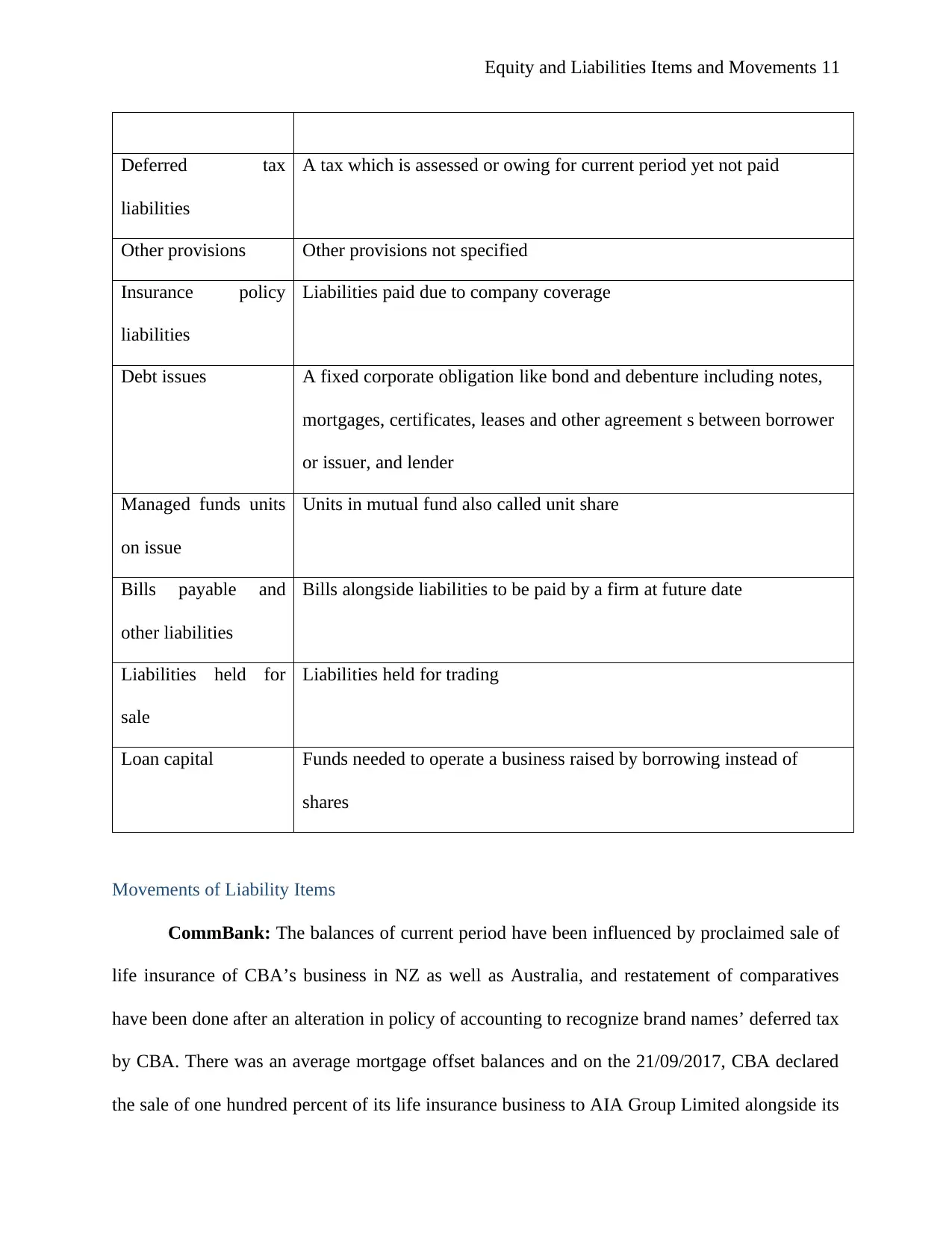
Equity and Liabilities Items and Movements 11
Deferred tax
liabilities
A tax which is assessed or owing for current period yet not paid
Other provisions Other provisions not specified
Insurance policy
liabilities
Liabilities paid due to company coverage
Debt issues A fixed corporate obligation like bond and debenture including notes,
mortgages, certificates, leases and other agreement s between borrower
or issuer, and lender
Managed funds units
on issue
Units in mutual fund also called unit share
Bills payable and
other liabilities
Bills alongside liabilities to be paid by a firm at future date
Liabilities held for
sale
Liabilities held for trading
Loan capital Funds needed to operate a business raised by borrowing instead of
shares
Movements of Liability Items
CommBank: The balances of current period have been influenced by proclaimed sale of
life insurance of CBA’s business in NZ as well as Australia, and restatement of comparatives
have been done after an alteration in policy of accounting to recognize brand names’ deferred tax
by CBA. There was an average mortgage offset balances and on the 21/09/2017, CBA declared
the sale of one hundred percent of its life insurance business to AIA Group Limited alongside its
Deferred tax
liabilities
A tax which is assessed or owing for current period yet not paid
Other provisions Other provisions not specified
Insurance policy
liabilities
Liabilities paid due to company coverage
Debt issues A fixed corporate obligation like bond and debenture including notes,
mortgages, certificates, leases and other agreement s between borrower
or issuer, and lender
Managed funds units
on issue
Units in mutual fund also called unit share
Bills payable and
other liabilities
Bills alongside liabilities to be paid by a firm at future date
Liabilities held for
sale
Liabilities held for trading
Loan capital Funds needed to operate a business raised by borrowing instead of
shares
Movements of Liability Items
CommBank: The balances of current period have been influenced by proclaimed sale of
life insurance of CBA’s business in NZ as well as Australia, and restatement of comparatives
have been done after an alteration in policy of accounting to recognize brand names’ deferred tax
by CBA. There was an average mortgage offset balances and on the 21/09/2017, CBA declared
the sale of one hundred percent of its life insurance business to AIA Group Limited alongside its
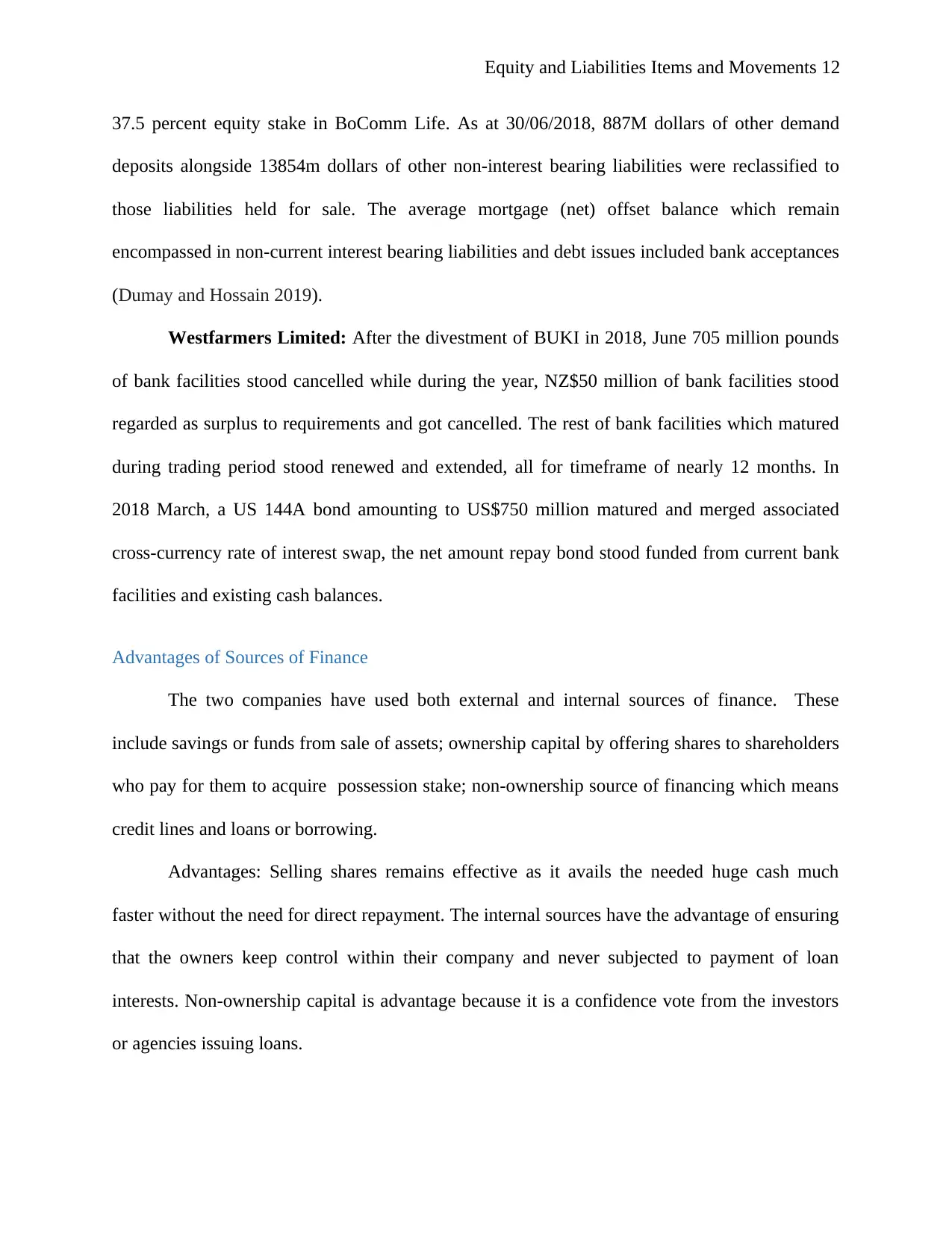
Equity and Liabilities Items and Movements 12
37.5 percent equity stake in BoComm Life. As at 30/06/2018, 887M dollars of other demand
deposits alongside 13854m dollars of other non-interest bearing liabilities were reclassified to
those liabilities held for sale. The average mortgage (net) offset balance which remain
encompassed in non-current interest bearing liabilities and debt issues included bank acceptances
(Dumay and Hossain 2019).
Westfarmers Limited: After the divestment of BUKI in 2018, June 705 million pounds
of bank facilities stood cancelled while during the year, NZ$50 million of bank facilities stood
regarded as surplus to requirements and got cancelled. The rest of bank facilities which matured
during trading period stood renewed and extended, all for timeframe of nearly 12 months. In
2018 March, a US 144A bond amounting to US$750 million matured and merged associated
cross-currency rate of interest swap, the net amount repay bond stood funded from current bank
facilities and existing cash balances.
Advantages of Sources of Finance
The two companies have used both external and internal sources of finance. These
include savings or funds from sale of assets; ownership capital by offering shares to shareholders
who pay for them to acquire possession stake; non-ownership source of financing which means
credit lines and loans or borrowing.
Advantages: Selling shares remains effective as it avails the needed huge cash much
faster without the need for direct repayment. The internal sources have the advantage of ensuring
that the owners keep control within their company and never subjected to payment of loan
interests. Non-ownership capital is advantage because it is a confidence vote from the investors
or agencies issuing loans.
37.5 percent equity stake in BoComm Life. As at 30/06/2018, 887M dollars of other demand
deposits alongside 13854m dollars of other non-interest bearing liabilities were reclassified to
those liabilities held for sale. The average mortgage (net) offset balance which remain
encompassed in non-current interest bearing liabilities and debt issues included bank acceptances
(Dumay and Hossain 2019).
Westfarmers Limited: After the divestment of BUKI in 2018, June 705 million pounds
of bank facilities stood cancelled while during the year, NZ$50 million of bank facilities stood
regarded as surplus to requirements and got cancelled. The rest of bank facilities which matured
during trading period stood renewed and extended, all for timeframe of nearly 12 months. In
2018 March, a US 144A bond amounting to US$750 million matured and merged associated
cross-currency rate of interest swap, the net amount repay bond stood funded from current bank
facilities and existing cash balances.
Advantages of Sources of Finance
The two companies have used both external and internal sources of finance. These
include savings or funds from sale of assets; ownership capital by offering shares to shareholders
who pay for them to acquire possession stake; non-ownership source of financing which means
credit lines and loans or borrowing.
Advantages: Selling shares remains effective as it avails the needed huge cash much
faster without the need for direct repayment. The internal sources have the advantage of ensuring
that the owners keep control within their company and never subjected to payment of loan
interests. Non-ownership capital is advantage because it is a confidence vote from the investors
or agencies issuing loans.
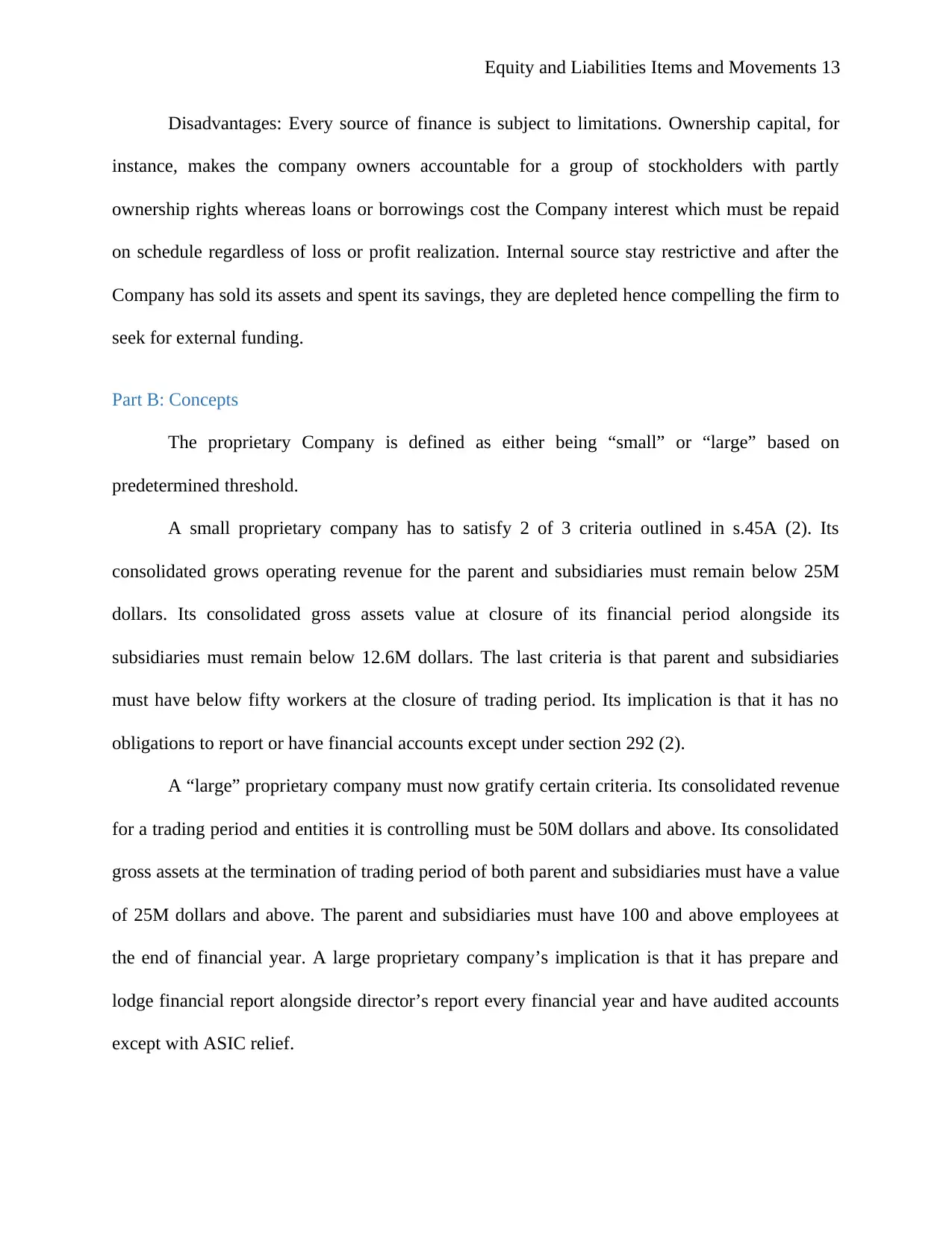
Equity and Liabilities Items and Movements 13
Disadvantages: Every source of finance is subject to limitations. Ownership capital, for
instance, makes the company owners accountable for a group of stockholders with partly
ownership rights whereas loans or borrowings cost the Company interest which must be repaid
on schedule regardless of loss or profit realization. Internal source stay restrictive and after the
Company has sold its assets and spent its savings, they are depleted hence compelling the firm to
seek for external funding.
Part B: Concepts
The proprietary Company is defined as either being “small” or “large” based on
predetermined threshold.
A small proprietary company has to satisfy 2 of 3 criteria outlined in s.45A (2). Its
consolidated grows operating revenue for the parent and subsidiaries must remain below 25M
dollars. Its consolidated gross assets value at closure of its financial period alongside its
subsidiaries must remain below 12.6M dollars. The last criteria is that parent and subsidiaries
must have below fifty workers at the closure of trading period. Its implication is that it has no
obligations to report or have financial accounts except under section 292 (2).
A “large” proprietary company must now gratify certain criteria. Its consolidated revenue
for a trading period and entities it is controlling must be 50M dollars and above. Its consolidated
gross assets at the termination of trading period of both parent and subsidiaries must have a value
of 25M dollars and above. The parent and subsidiaries must have 100 and above employees at
the end of financial year. A large proprietary company’s implication is that it has prepare and
lodge financial report alongside director’s report every financial year and have audited accounts
except with ASIC relief.
Disadvantages: Every source of finance is subject to limitations. Ownership capital, for
instance, makes the company owners accountable for a group of stockholders with partly
ownership rights whereas loans or borrowings cost the Company interest which must be repaid
on schedule regardless of loss or profit realization. Internal source stay restrictive and after the
Company has sold its assets and spent its savings, they are depleted hence compelling the firm to
seek for external funding.
Part B: Concepts
The proprietary Company is defined as either being “small” or “large” based on
predetermined threshold.
A small proprietary company has to satisfy 2 of 3 criteria outlined in s.45A (2). Its
consolidated grows operating revenue for the parent and subsidiaries must remain below 25M
dollars. Its consolidated gross assets value at closure of its financial period alongside its
subsidiaries must remain below 12.6M dollars. The last criteria is that parent and subsidiaries
must have below fifty workers at the closure of trading period. Its implication is that it has no
obligations to report or have financial accounts except under section 292 (2).
A “large” proprietary company must now gratify certain criteria. Its consolidated revenue
for a trading period and entities it is controlling must be 50M dollars and above. Its consolidated
gross assets at the termination of trading period of both parent and subsidiaries must have a value
of 25M dollars and above. The parent and subsidiaries must have 100 and above employees at
the end of financial year. A large proprietary company’s implication is that it has prepare and
lodge financial report alongside director’s report every financial year and have audited accounts
except with ASIC relief.
Paraphrase This Document
Need a fresh take? Get an instant paraphrase of this document with our AI Paraphraser
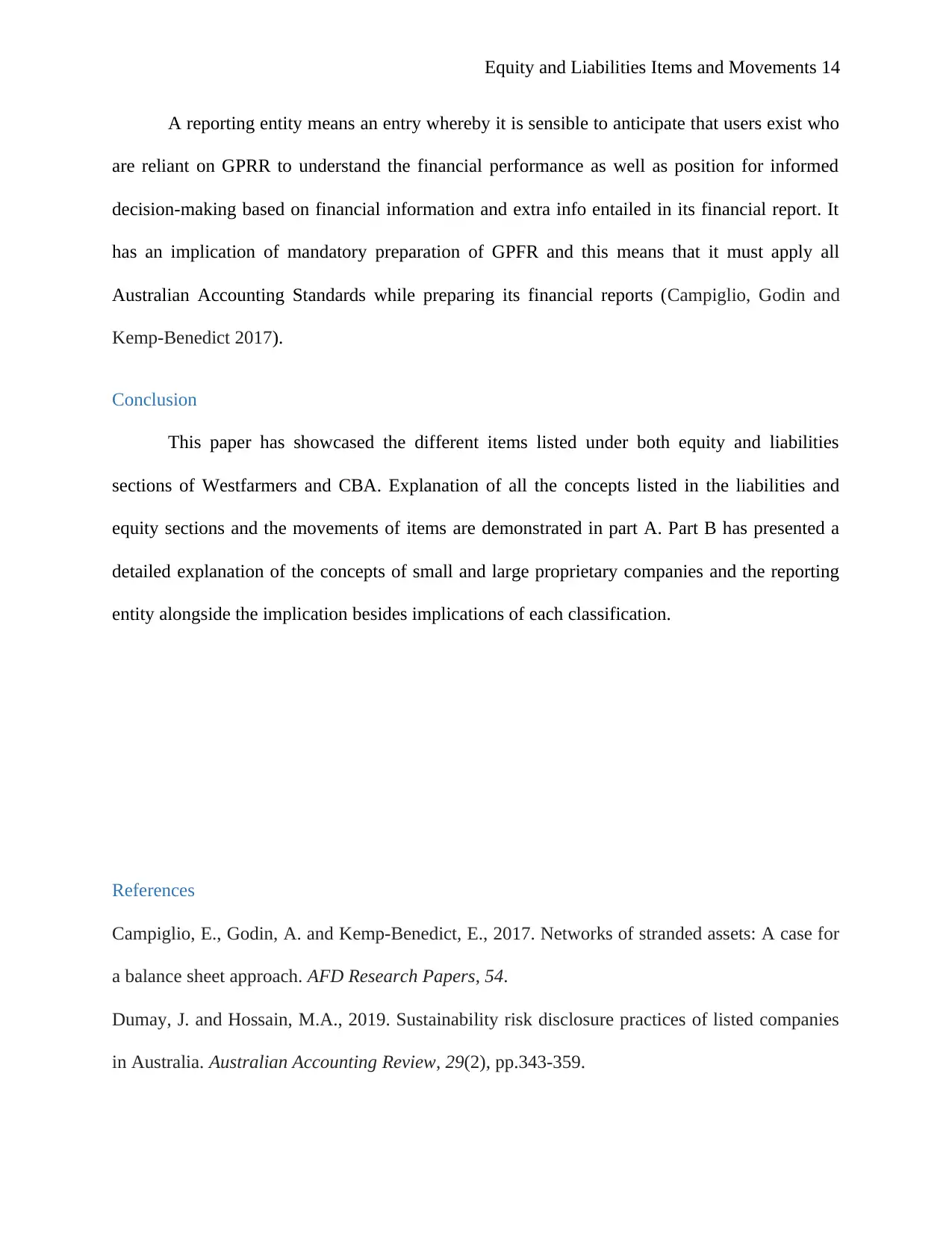
Equity and Liabilities Items and Movements 14
A reporting entity means an entry whereby it is sensible to anticipate that users exist who
are reliant on GPRR to understand the financial performance as well as position for informed
decision-making based on financial information and extra info entailed in its financial report. It
has an implication of mandatory preparation of GPFR and this means that it must apply all
Australian Accounting Standards while preparing its financial reports (Campiglio, Godin and
Kemp-Benedict 2017).
Conclusion
This paper has showcased the different items listed under both equity and liabilities
sections of Westfarmers and CBA. Explanation of all the concepts listed in the liabilities and
equity sections and the movements of items are demonstrated in part A. Part B has presented a
detailed explanation of the concepts of small and large proprietary companies and the reporting
entity alongside the implication besides implications of each classification.
References
Campiglio, E., Godin, A. and Kemp-Benedict, E., 2017. Networks of stranded assets: A case for
a balance sheet approach. AFD Research Papers, 54.
Dumay, J. and Hossain, M.A., 2019. Sustainability risk disclosure practices of listed companies
in Australia. Australian Accounting Review, 29(2), pp.343-359.
A reporting entity means an entry whereby it is sensible to anticipate that users exist who
are reliant on GPRR to understand the financial performance as well as position for informed
decision-making based on financial information and extra info entailed in its financial report. It
has an implication of mandatory preparation of GPFR and this means that it must apply all
Australian Accounting Standards while preparing its financial reports (Campiglio, Godin and
Kemp-Benedict 2017).
Conclusion
This paper has showcased the different items listed under both equity and liabilities
sections of Westfarmers and CBA. Explanation of all the concepts listed in the liabilities and
equity sections and the movements of items are demonstrated in part A. Part B has presented a
detailed explanation of the concepts of small and large proprietary companies and the reporting
entity alongside the implication besides implications of each classification.
References
Campiglio, E., Godin, A. and Kemp-Benedict, E., 2017. Networks of stranded assets: A case for
a balance sheet approach. AFD Research Papers, 54.
Dumay, J. and Hossain, M.A., 2019. Sustainability risk disclosure practices of listed companies
in Australia. Australian Accounting Review, 29(2), pp.343-359.
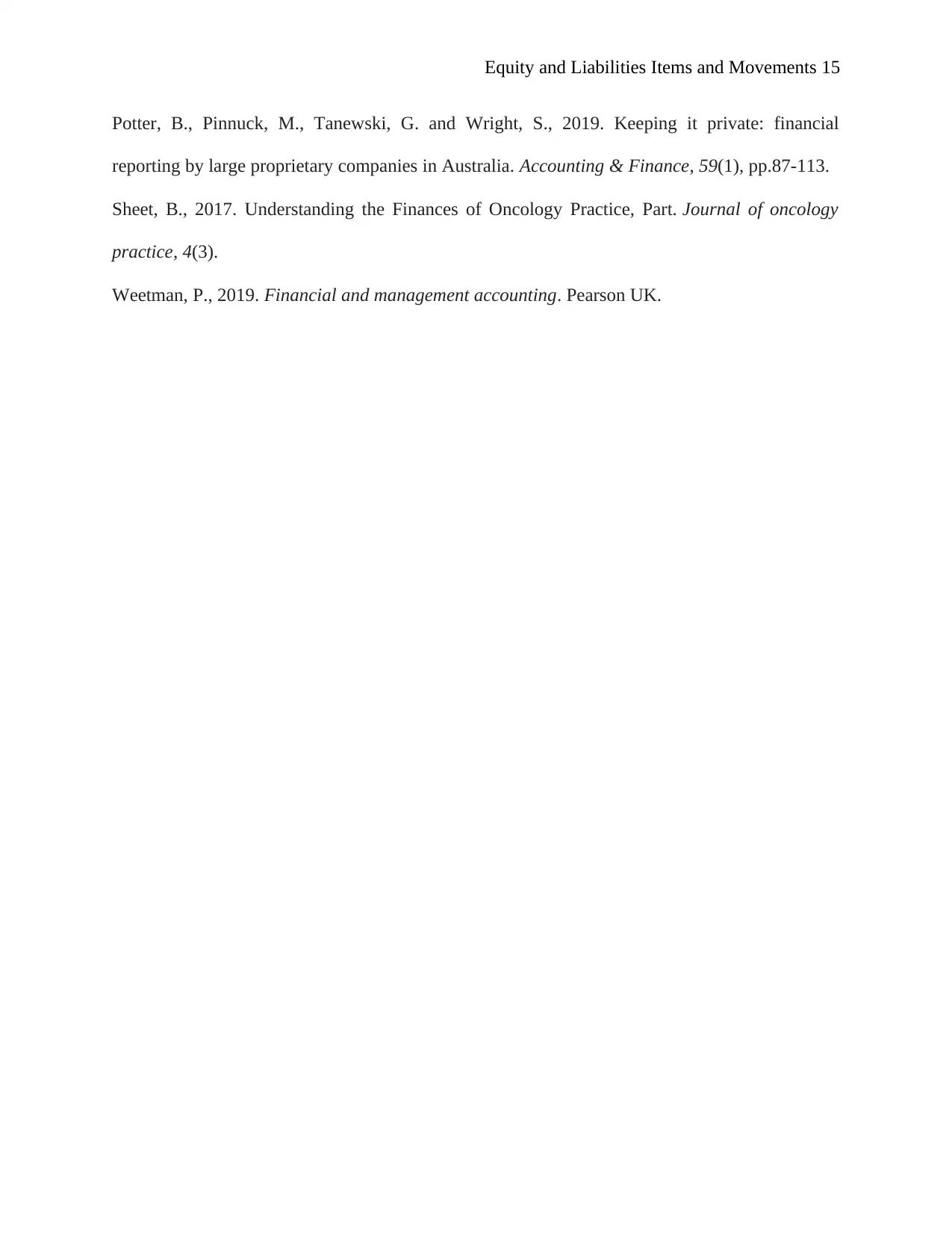
Equity and Liabilities Items and Movements 15
Potter, B., Pinnuck, M., Tanewski, G. and Wright, S., 2019. Keeping it private: financial
reporting by large proprietary companies in Australia. Accounting & Finance, 59(1), pp.87-113.
Sheet, B., 2017. Understanding the Finances of Oncology Practice, Part. Journal of oncology
practice, 4(3).
Weetman, P., 2019. Financial and management accounting. Pearson UK.
Potter, B., Pinnuck, M., Tanewski, G. and Wright, S., 2019. Keeping it private: financial
reporting by large proprietary companies in Australia. Accounting & Finance, 59(1), pp.87-113.
Sheet, B., 2017. Understanding the Finances of Oncology Practice, Part. Journal of oncology
practice, 4(3).
Weetman, P., 2019. Financial and management accounting. Pearson UK.
1 out of 15
Related Documents
Your All-in-One AI-Powered Toolkit for Academic Success.
+13062052269
info@desklib.com
Available 24*7 on WhatsApp / Email
![[object Object]](/_next/static/media/star-bottom.7253800d.svg)
Unlock your academic potential
© 2024 | Zucol Services PVT LTD | All rights reserved.




